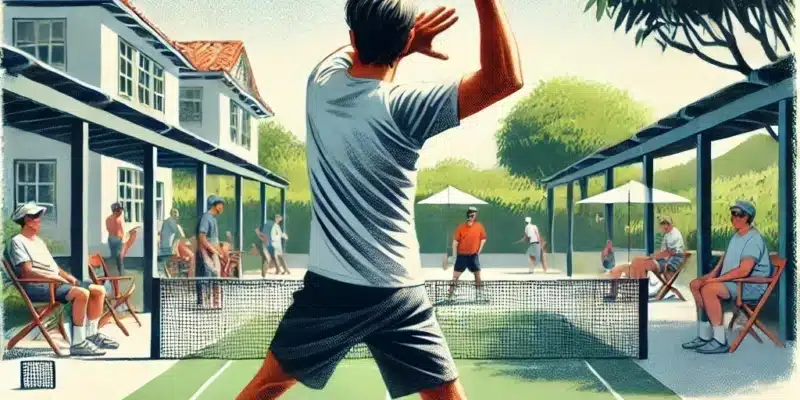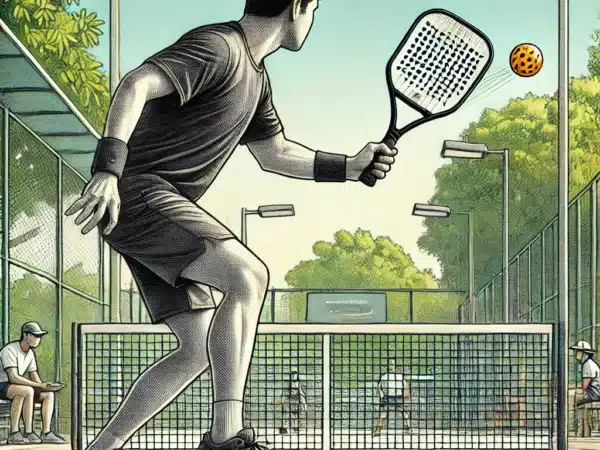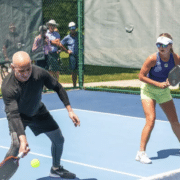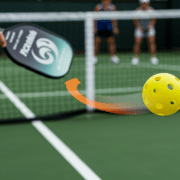Overhead technique in pickleball

One of the most effective shots in pickleball is the overhead shot, which can turn the tide of the game. But to use it to its fullest potential, you need to master the right technique. This article will help you learn how to perform powerful and accurate overheads, turning them from a weakness to your weapon of victory.
If you are looking for a full article about the rules of pickleball, we mentioned them in this article.
Page contents
What is an overhead in pickleball?
An overhead is a strong attacking stroke that is usually used to hit high balls, candles, or bad serves from the opponent. It is a powerful tool that allows you to finish a point with one shot, but can also lead to an error if not executed correctly.
Technique of hitting the ball overhead
- Correct positioning:
When the ball goes into the air, don’t step back. Instead, move quickly to the side to get into the best position to hit it. - Preparing for the stroke:
Raise the racket to ear level, keeping it slightly tilted back, elbow raised. Extend your arm without the racket forward, pointing it at the ball. - Contact with the ball:
Swing the racket so that it is perpendicular to the ball’s flight path. For right-handed players, the ideal point of contact is approximately at 1 o’clock on an imaginary clock in front of you, for left-handed players, at 11 o’clock. - Swing and continuation of movement:
Perform a full extension of the arm during the stroke. After making contact with the ball, continue to move the racket down and slightly to the side, diagonally towards the opponent’s field. - Angle control:
It is very important to monitor the angle of the racket. It should be pointed downward toward the opponent’s field so that the ball does not fly out of bounds, but not too low to avoid hitting the net. - Adding angles:
To make it harder for your opponent to receive the ball, try adding angles to your overhead by directing the ball to the left or right.
Common mistakes and how to avoid them
- Retreating backwards:
Always move sideways, not backwards. - Incorrect racket angle:
Control the racket angle to avoid hitting the net or out of bounds. - Lowering the head:
Keep your head and shoulders straight during the stroke. - Too soft of a stroke:
Use full arm and body strength for a powerful stroke.
With the help of this article and regular practice, you will be able to turn the overhead into your strong point in pickleball, taking your game to the next level.
Frequently asked questions and answers
An overhead is an attacking overhead shot used to hit high balls, candles, or weak serves of the opponent. It is a powerful technique that can end a game in one shot.
An overhead is effective when the opponent hits a bad forehand or serve, giving you the opportunity to attack a high ball.
Move sideways, not backwards, to get into the best position for the shot.
Position yourself so that the ball is in front of you when you hit.
Preparation: Hold the racket at ear level, elbow raised, racketless hand pointing at the ball.
Contact with the ball: The shot is struck at 1 o’clock for right-handed players and at 11 o’clock for left-handed players.
Swing: The arm must be fully extended and the movement after the stroke must be diagonally downward toward the opponent’s court.
Hold the racket at an angle pointing downward toward the opponent’s court. This will help avoid hitting the net or out of bounds.
Add angles to your shot by directing the ball to the left or right to make it more difficult for your opponent to receive it.
Use the strength of your arm and body to create a powerful punch.
Stepping backwards: Always move sideways, not backwards, to maintain balance.
Incorrect racket angle: Avoid having a racket angle that is too open or closed.
Head lowering: Keep your head straight to avoid losing control of the stroke.
Weak st roke: Don’t be afraid to use force to deliver a powerful shot.
An overhead allows you to quickly complete the draw, creating an advantage in the game. This is one of the most effective attacking techniques in pickleball.
Practice proper ball positioning and control techniques.
Train your hitting power and accuracy by focusing on the angles and trajectory of the ball.
Practice your overhead regularly, paying attention to technique, accuracy, and strength. Use these strokes unpredictably to create an advantage over your opponent.












